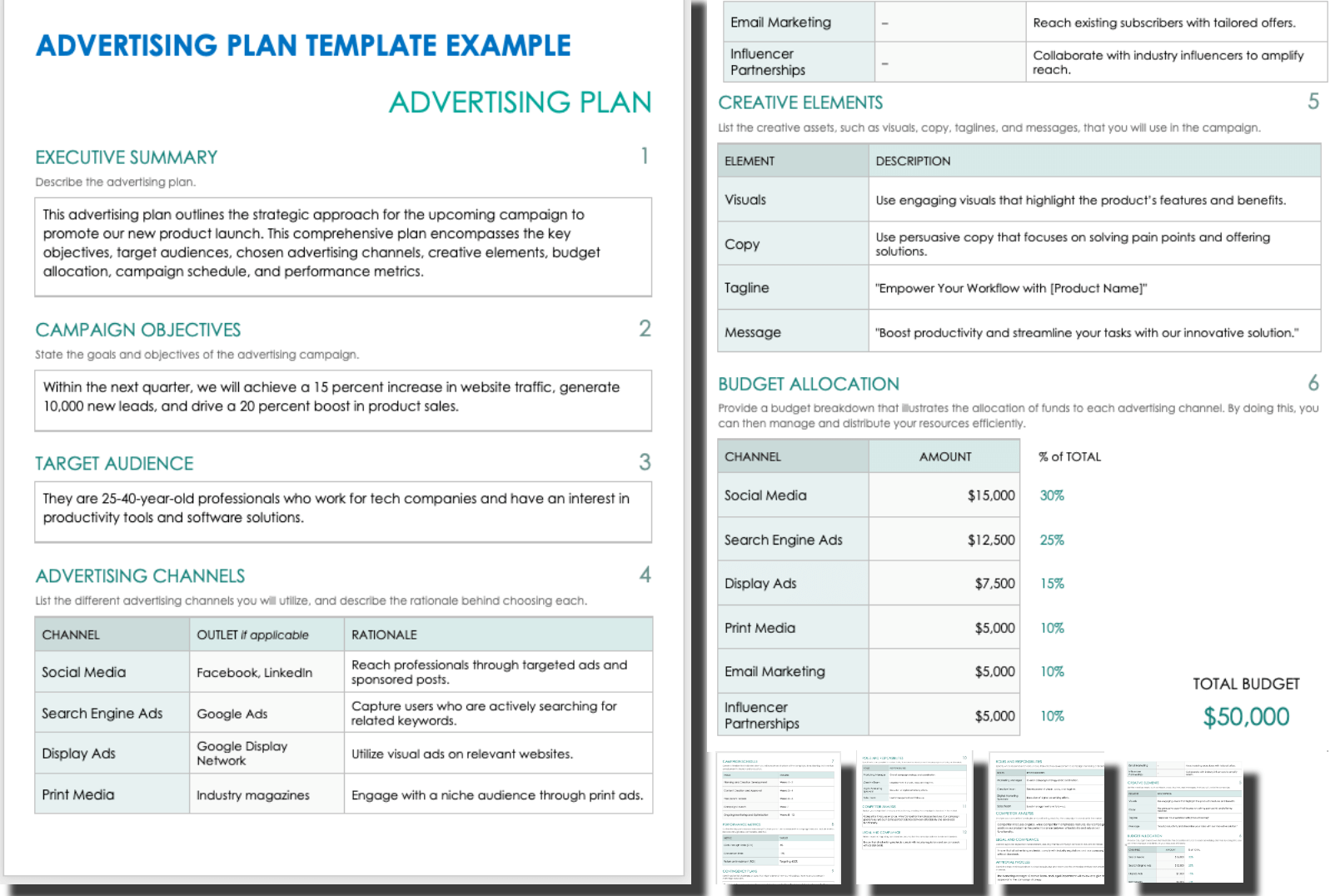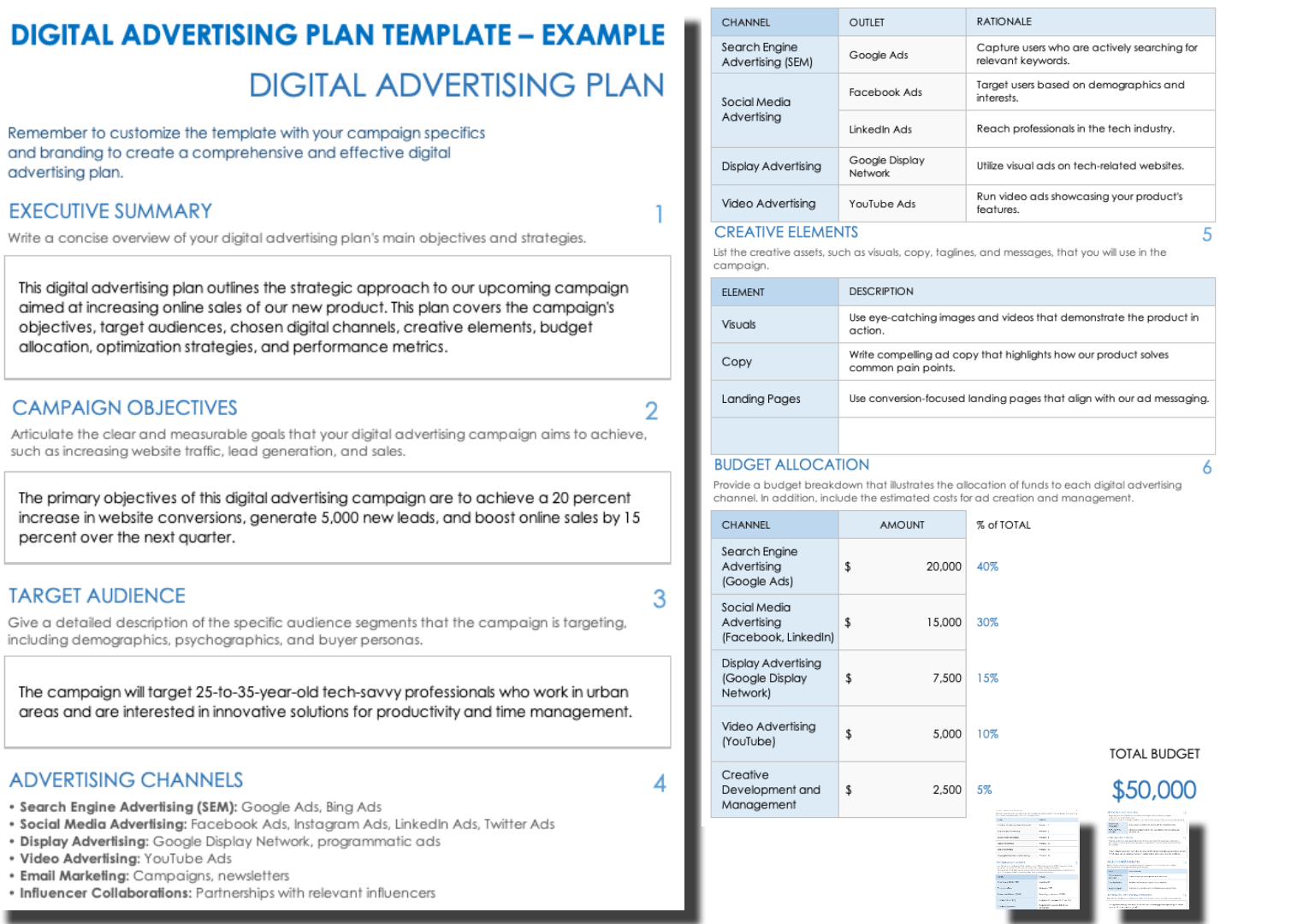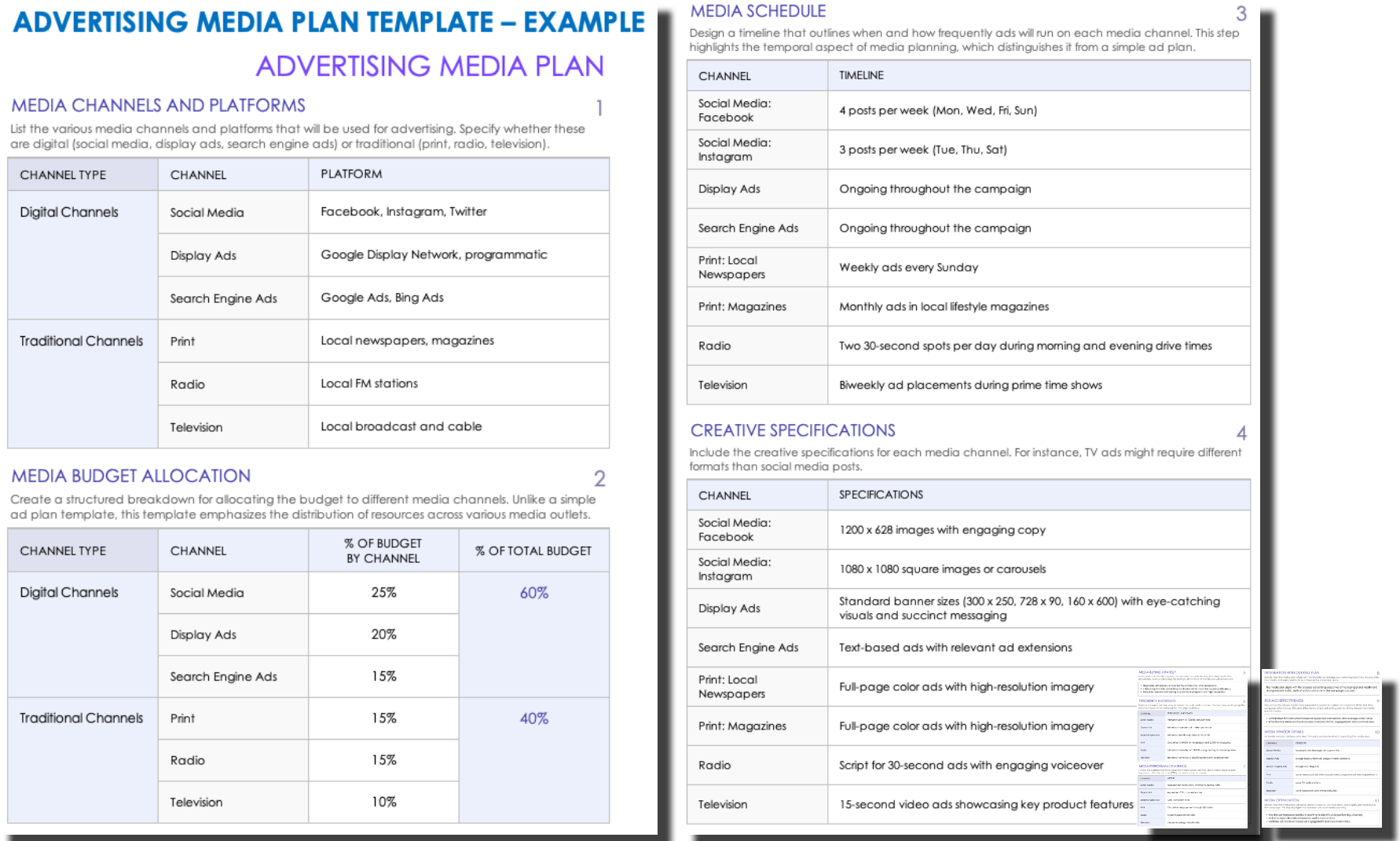Advertising Plan Template
Download an Advertising Plan Example Template for
Excel
|
Microsoft Word
|
Adobe PDF
| Google Sheets
Download a Blank Advertising Plan Template for
Excel
|
Microsoft Word
|
Adobe PDF
|
PowerPoint
| Google Sheets| Google Slides
Utilize this straightforward advertising plan template to meticulously structure, implement, and assess your advertising strategy for everything from singular campaigns to extensive organizational initiatives. Begin by delineating the advertising channels, the frequency of communication, and the target audience for each stakeholder. Then, input these particulars into the template to craft a well-defined advertising plan. This template is an invaluable tool to share with stakeholders and essential team members, fostering clear alignment throughout your advertising initiatives.
Check out this page of advertising templates for more options to perfect your advertising strategy. For additional guidance with marketing and advertising planning, see this comprehensive guide and collection of marketing plan templates.
Digital Advertising Plan Template
Download a Digital Advertising Plan Example Template for
Excel
|
Microsoft Word
|
Adobe PDF
| Google Sheets
Download a Blank Digital Advertising Plan Template for
Excel
|
Microsoft Word
|
Adobe PDF
| Google Sheets
Use this straightforward digital advertising plan template to plan, execute, and analyze your digital advertising strategies, whether for a singular campaign or a broader organizational initiative. Begin by pinpointing the digital avenues, communication intervals, and precise target audience for each element of your plan. Then, map out your plan for executing each element on the template’s month-by-month timeline. Tailored explicitly for the digital realm, this template assists with the methodical planning and execution of online advertising.
See this collection of advertising proposal templates for more options and information on developing and implementing your marketing strategies.
Advertising Media Plan Template
Download an Advertising Media Plan Example Template for
Excel
|
Microsoft Word
|
Adobe PDF
| Google Sheets
Download a Blank Advertising Media Plan Template for
Excel
|
Microsoft Word
|
Adobe PDF
| Google Sheets
Utilize this user-friendly advertising media plan template to organize, execute, and assess your advertising media strategies. Start by identifying the advertising media channels, communication frequency, and the specific audience for each stakeholder. Then, easily enter this information into the template to create a comprehensive and clear advertising media plan. This template is designed to cater to the nuances of advertising media, offering a practical approach to planning and execution. By covering a variety of channels, from traditional to digital media platforms, this template promotes precision in your advertising strategies. It serves as a valuable tool for sharing insights with stakeholders and key team members, ensuring a seamless alignment throughout your advertising media planning process.
Choose from this complete collection of advertising campaign templates to elevate your advertising and marketing pursuits.
What Is an Advertising Plan?
An advertising plan is a strategic document that outlines the strategies, tactics, and actions a business will use to promote its products or services. This document defines the approach for reaching and engaging the target audience through various advertising channels.
An advertising plan encompasses key elements such as campaign objectives, target audience identification, message development, channel selection, budget allocation, timeline, and performance measurement. This plan serves as a guiding framework to ensure that advertising efforts are coordinated, purposeful, and aligned with the broader marketing objectives of the organization.
What Is an Advertising Plan Template?
An advertising plan template is a structured document that serves as a strategic roadmap for planning and executing advertising efforts. This detailed framework outlines the steps, goals, and tactics necessary to create and implement successful advertising campaigns.
An advertising plan template includes space to document the campaign's objectives, target audience, messaging, creative elements, budget allocation, and scheduling. By providing a centralized and organized structure, a template ensures that all team members are on the same page.
This tool empowers you to think critically about every facet of your advertising endeavors. From identifying the ideal channels for reaching their audience to crafting compelling messages and visuals, an advertising plan template lays the foundation for a cohesive and impactful campaign. It's a dynamic document that encourages collaboration, fosters creativity, and ultimately drives the achievement of marketing goals.
What Is Included in an Advertising Plan Template?
An advertising plan template includes the essential components of an effective advertising strategy, such as objectives, target audience, and advertising channels. It serves as a guide for your business to organize and plan your advertising efforts cohesively.
The following elements are typically included in an advertising plan template:
- Campaign Objectives: Clearly define goals that the advertising campaign aims to achieve, such as increasing brand awareness, driving website traffic, boosting sales, or launching a new product.
- Target Audience: Write a detailed description of the intended audience that includes demographics, psychographics, behaviors, and preferences, to tailor messages and choose appropriate channels.
- Advertising Channels: Identify the specific platforms or channels where ads will be deployed, such as social media, search engines, display networks, print media, and more.
- Message and Creative: Develop compelling messages, taglines, visuals, and creative elements that resonate with the target audience and align with the brand's identity.
- Budget Allocation: Determine the budget for the campaign and allocate funds to different advertising channels to ensure effective resource distribution.
- Campaign Schedule: Set start and end dates for the campaign, and create a timeline for when ads will run on each selected channel.
- Metrics and Measurement: Specify key performance indicators (KPIs) that will be used to measure the success of the campaign, such as click-through rates, conversion rates, and ROI.
- Testing and Optimization: Describe how the campaign will be tested and optimized throughout its duration, whether that involves A/B testing, targeting adjustments, or creative modifications.
- Contingency Plans: Consider potential challenges or issues that may arise during the campaign, and outline contingency plans.
- Roles and Responsibilities: Identify which team members will be responsible for different aspects of the campaign.
- Brand Guidelines: Integrate brand guidelines to help teams maintain consistency in messaging, visuals, and overall brand identity.
- Competitor Analysis: Evaluate competitors' advertising strategies and positioning to gain insights and inform your approach.
- SWOT Analysis: Identify strengths, weaknesses, opportunities, and threats related to the advertising campaign.
- Legal and Compliance Considerations: Address legal and regulatory requirements to ensure that the campaign adheres to relevant laws and standards.
- Approval Process: Define the steps and stakeholders involved in reviewing and approving the campaign strategy and creative materials.
How to Create an Advertising Plan
Creating a well-structured advertising plan template is critical for managing your advertising efforts and achieving your marketing goals. An advertising plan helps you outline your strategy, allocate resources effectively, and ensure your messaging reaches the right audience.
This guide walks you through the essential steps to create a comprehensive advertising plan template that sets the foundation for successful campaigns:
- Define Your Objectives: Start by clearly defining your advertising objectives. What do you aim to achieve with your advertising efforts? Whether it's boosting brand awareness, driving website traffic, increasing sales, or launching a new product, your objectives will shape the rest of your plan.
- Identify Your Target Audience: Understand your target audience's demographics, behaviors, preferences, and pain points. This information will help you tailor your advertising messages to resonate with your audience and increase the likelihood of engagement.
- Conduct a Competitive Analysis: Study your competitors to gain insights into their advertising strategies. Identify their strengths, weaknesses, and unique selling propositions. This analysis will help you position your brand effectively in the market.
- Choose Your Advertising Channels: Select the most suitable advertising channels to reach your target audience. Consider options such as social media, search engine ads, display ads, influencer collaborations, print media, and more. Each channel should align with your target audience's preferences and behaviors.
- Craft Your Message and Creatives: Develop compelling advertising messages that convey your value proposition clearly and resonate with your audience. Create eye-catching visuals, headlines, and copy that engage and captivate your viewers. Ensure consistency across all creatives to maintain a cohesive brand identity.
- Set Your Budget: Determine your advertising budget based on your objectives, available resources, and the competitiveness of your industry. Allocate funds to each advertising channel and ensure your budget aligns with your goals.
- Plan the Advertising Schedule: Create a timeline for your advertising activities. Determine when each campaign will launch, how long it will run, and when you'll assess its performance. Factor in seasonal trends, product launches, and key events relevant to your audience.
- Monitor and Measure Performance: Define KPIs to measure the success of your advertising campaigns. Track metrics such as click-through rates, conversion rates, engagement metrics, and ROI. Regularly assess your campaigns' performance to identify areas for improvement.
- Adapt and Optimize: Based on the data you gather, continuously optimize your advertising campaigns. Adjust your messaging, targeting, and channel selection to improve results over time. A willingness to adapt and refine your approach will lead to better outcomes.
- Document and Communicate Your Plan: Compile all the information into your advertising plan template. Include sections for each step, outlining your objectives, target audience, channels, budget, creatives, schedule, and measurement methods. Share this template with your team to ensure everyone is aligned and aware of the plan's details.
Creating a comprehensive advertising plan template helps you guide your strategies, set expectations, and measure results, laying the groundwork for successful campaigns. By following these steps and continuously refining your approach, you'll be well-equipped to launch effective advertising campaigns that drive meaningful results for your business.
Supercharge Your Advertising Plans with Real-Time Work Management in Smartsheet
Empower your people to go above and beyond with a flexible platform designed to match the needs of your team — and adapt as those needs change.
The Smartsheet platform makes it easy to plan, capture, manage, and report on work from anywhere, helping your team be more effective and get more done. Report on key metrics and get real-time visibility into work as it happens with roll-up reports, dashboards, and automated workflows built to keep your team connected and informed.
When teams have clarity into the work getting done, there’s no telling how much more they can accomplish in the same amount of time. Try Smartsheet for free, today.


